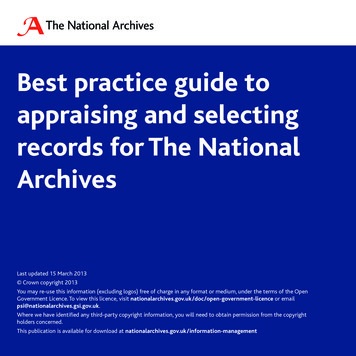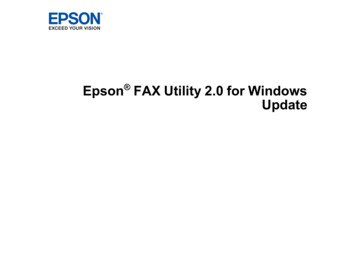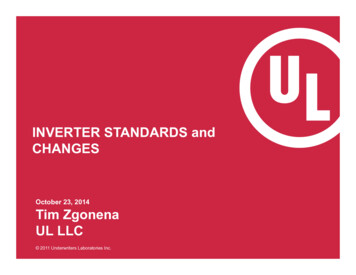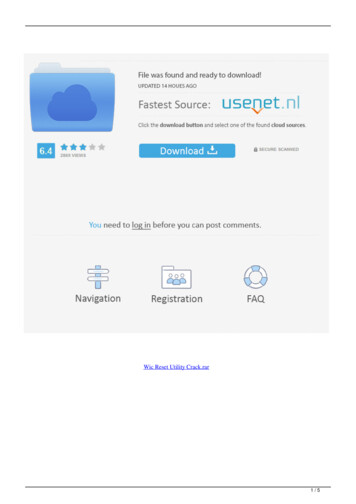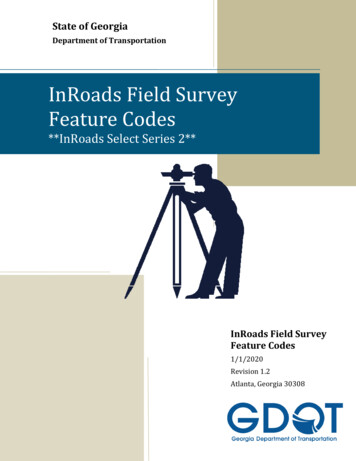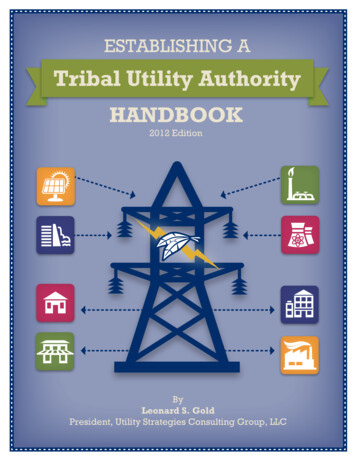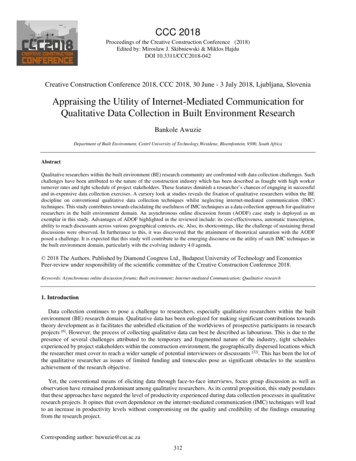
Transcription
CCC 2018Proceedings of the Creative Construction Conference (2018)Edited by: Miroslaw J. Skibniewski & Miklos HajduDOI 10.3311/CCC2018-042Creative Construction Conference 2018, CCC 2018, 30 June - 3 July 2018, Ljubljana, SloveniaAppraising the Utility of Internet-Mediated Communication forQualitative Data Collection in Built Environment ResearchBankole AwuzieDepartment of Built Environment, Centrl University of Technology,Westdene, Bloemfontein, 9300, South AfricaAbstractQualitative researchers within the built environment (BE) research community are confronted with data collection challenges. Suchchallenges have been attributed to the nature of the construction industry which has been described as fraught with high workerturnover rates and tight schedule of project stakeholders. These features diminish a researcher’s chances of engaging in successfuland in-expensive data collection exercises. A cursory look at studies reveals the fixation of qualitative researchers within the BEdiscipline on conventional qualitative data collection techniques whilst neglecting internet-mediated communication (IMC)techniques. This study contributes towards elucidating the usefulness of IMC techniques as a data collection approach for qualitativeresearchers in the built environment domain. An asynchronous online discussion forum (AODF) case study is deployed as anexemplar in this study. Advantages of ADOF highlighted in the reviewed include: its cost-effectiveness, automatic transcription,ability to reach discussants across various geographical contexts, etc. Also, its shortcomings, like the challenge of sustaining threaddiscussions were observed. In furtherance to this, it was discovered that the attainment of theoretical saturation with the AODFposed a challenge. It is expected that this study will contribute to the emerging discourse on the utility of such IMC techniques inthe built environment domain, particularly with the evolving industry 4.0 agenda. 2018 The Authors. Published by Diamond Congress Ltd., Budapest University of Technology and EconomicsPeer-review under responsibility of the scientific committee of the Creative Construction Conference 2018.Keywords: Asynchronous online discussion forums; Built environment; Internet-mediated Communication; Qualitative research1. IntroductionData collection continues to pose a challenge to researchers, especially qualitative researchers within the builtenvironment (BE) research domain. Qualitative data has been eulogized for making significant contributions towardstheory development as it facilitates the unbridled elicitation of the worldviews of prospective participants in researchprojects [6]. However, the process of collecting qualitative data can best be described as labourious. This is due to thepresence of several challenges attributed to the temporary and fragmented nature of the industry, tight schedulesexperienced by project stakeholders within the construction environment, the geographically dispersed locations whichthe researcher must cover to reach a wider sample of potential interviewees or discussants [22]. This has been the lot ofthe qualitative researcher as issues of limited funding and timescales pose as significant obstacles to the seamlessachievement of the research objective.Yet, the conventional means of eliciting data through face-to-face interviews, focus group discussion as well asobservation have remained predominant among qualitative researchers. As its central proposition, this study postulatesthat these approaches have negated the level of productivity experienced during data collection processes in qualitativeresearch projects. It opines that overt dependence on the internet-mediated communication (IMC) techniques will leadto an increase in productivity levels without compromising on the quality and credibility of the findings emanatingfrom the research project.Corresponding author: bawuzie@cut.ac.za312
CCC 2018 ProceedingsDOI 10.3311/CCC2018-042The advent of the internet in the 80’s and 90’s has led to a transformational curve across various facets ofcontemporary living [25, 27]. As such, significant improvements leading to efficiency and increased productivity haveleveraged on this innovation. The educational sector remains a major beneficiary of the internet as the medium hasbeen applied towards the development of pedagogical platforms for sharing knowledge between persons situated acrossgeographically dispersed locations on a real-time, online basis without any time and distance barriers [21]. This hasproven to be a cost-effective approach to pedagogy as many academic institutions have resorted to hosting theirprogrammes through internet-/computer-mediated platforms and improving staff and student productivity [1]. As such,significant investments are continually being made by academic institutions at different levels to foster an internetdependent culture across the entire gamut of their institutional activities. Although the use of the IMC platforms appearsto have been extensively deployed in improving teaching and learning processes in these institutions, it appears that itis yet, a new concept to qualitative researchers within the BE research space [16]. Partly, the apathy to the optimalutilization of IMC techniques in engendering effective and efficient data collection processes have resulted from theuncertainty surrounding its adoption and deployment [25]. Such uncertainty stems from issues like the acceptability ofthe findings resulting from the study, security of information shared over such platforms and willingness of participantsto share such information across such platforms, the level of access to internet connectivity as well as ability to engagewith the internet in certain contexts by certain categories of participants which may affect participation levels, etc. [16,5].But, [27] Turney and Pocknee (2005) admit to the vast opportunity presented by the internet and internet-enabledplatforms in supporting the researcher’s ability to document data in a text format, providing conducive environmentsfor participants to voice their opinions pertaining to a phenomenon. In furtherance to this, a review of existing literaturereveals a paucity of literature detailing a procedural approach to the deployment of these IMC platforms by qualitativeresearchers, both within and outside the BE domain during data elicitation processes [11]. Perhaps, the abundance ofsuch articles as is the case with the pedagogical facets will engender increased utilization of IMC platforms amongresearchers. This is a gap which this study seeks to bridge. [16] Im and Chee (2006) admit this when they bemoan thelow level of awareness in the research community regarding the practical issues associated with the use of the onlineplatforms for data elicitation. Accordingly, this study will provide an insight into the utility of such IMC platforms inthe collection of qualitative data within the BE context, relying on an asynchronous online discussion forum (AODF)exemplar. Furthermore, it will highlight the advantages as well as shortcomings of the AODF experienced by theresearcher during the study being presented and the steps taken to surmount these challenges.To achieve its objective, this study will be structured thus: a review of relevant literature on the nature of onlinediscussion forums; a reflection on the similarities between AODFs and conventional focus group discussion platforms;the nature of the construction industry and BE research; an exposé on the study within which the AODF was appliedto collect data; a reflection on the drivers, merits, challenges and ethical considerations experienced during thedeployment of the AODF in the study, and; a conclusion.2. Literature review2.1. Online discussion forumsThe advent of the internet appears to have brought in its wake a paradigmatic shift in the way certain processes wereexecuted [5, 7, 2]. They admit that the internet is a veritable platform for carrying out unbiased research and offers theresearcher with an opportunity of experiencing a plethora of nuanced instances which may not have been possible withthe conventional modes of data collection. Also, [25] observe the burgeoning rise of the internet usage in the researchcommunity despite little reportage. They identify the utility of the internet in carrying out literature reviews, and thecompilation of bibliographic databases among other aspects. The rise in the use of IMC platforms to facilitateborderless dissemination of knowledge as well as information sharing across multiple platforms evolved from this era.Online discussion forums are IMC platforms which have been extensively deployed towards knowledgecreation/development and dissemination among different individuals across different locations. In elucidating theusefulness of online discussion forums, Gao et al (2013) [11] catalogue a variety of uses to which such platforms can be313
CCC 2018 ProceedingsDOI 10.3311/CCC2018-042put to. Examples of such uses include the development of online communities, enabling unbridled information andknowledge exchange, provision of a platform for collaborative problem-solving and critical and reflexive thinking.Whereas online discussion forums have a long history of being applied in the pedagogical undertakings in academicinstitutions, its introduction to the research community can be described as relatively nascent [5, 17, 27, 24]. However, theyopine that its adoption within the research context has availed researchers with an opportunity to gain access topreviously hard to reach groups. This was buttressed in a recent study [19] wherein an online discussion forum was usedgathering qualitative data from young people who have experienced breakups in romantic relationships and in anotherstudy, wherein online discussion forums where applied in understudying the perception of the youth on the burgeoninghousing issues in their locality by [20]. Maestre et al. (2018) [18] highlight the salient nature of online discussion forumsin researching into stigmatized groups. Whilst it should be acknowledged that the participants in a multiplicity of BEresearch projects cannot be assigned the toga of a ‘hard to reach’ sample, it is often difficult to recruit probableparticipants. This difficulty is because of the different factors which have been mentioned previously in the precedingsection. The presence of such challenges which are peculiar to BE context accentuates the need for the adoption andutilization of IMC platforms to gather data in an effective and efficient manner. Online discussion forums are classifiedaccording to two distinct categories, namely: synchronized and asynchronized online discussion forums [25]. Whereasthe synchronized communication takes place online, real-time and instantaneously, the latter avails participants withan opportunity to provide answers at their convenience. Examples of the former include online chat-rooms and onlineinterviewing platforms such as Skype and other types of voice over internet protocol (VOIP) platforms whereas onlinediscussion forums/ boards can be classified as being asynchronous discussion platforms. Also, the asynchronouscategory allows for participants to join in on any discussion at their convenience without prompting, the synchronouscategory does not allow for this as it is instant [20].In this study, the intention is to provide a detailed account of the application of an AODF in the collection ofqualitative data from a group of discussants who would ordinarily have been difficult to access based on their locationsand time zones. In this wise, the AODF was utilized as a replacement of the conventional focus group discussion whichappears to be prevalent in contemporary BE research.2.2. Asynchronous online Discussion Forums as Focus GroupsAs mentioned earlier, AODFs have been likened to conventional focus group discussion exercises albeit conductedon an IMC platform to engender wider participation [26]. Lim and Tan (2001) [17] compare the features of a focus groupdiscussion forum and AODF and conclude that the AODF fared better. Aspects were the AODF was found to haveproven advantageous in the comparative exercise include: convenience, reduced instances of social interference,reduction in group-think as individuals could air their views without coercion, opportunities for reflection by thediscussants and adequate control was provided to facilitators. Furthermore, transcription was made easier given thatdiscussants were expected to provide their opinions in textual format. Most of these advantages have been highlightedin recent studies such as [17]. Conversely, scholars have also identified the failings of the AODF in terms of the highincidence of discontinuous threads, the need for participants to possess the requisite computer literacy skills as well asthe absence of non-verbal clues [17, 12].Based on the foregoing, this study was carried out to buttress the salient benefits accruable from the deployment ofAODFs in the collection of qualitative data by BE researchers. This is considered imperative in view of the increasinglynew reputation of BE professionals as a ‘hard to reach’ sample owing to peculiarities associated with the industry.2.3. The Built Environment domain and its ‘hard to reach’ sampleRole players within the BE context are often occupied on projects with tight time schedules. It is becomingincreasingly difficult for researchers conducting studies within this context to reach them and elicit their viewspertaining to problems beleaguering the industry. However, qualitative data remains critical to the development ofcontext-dependent theory as well as its usefulness in gaining both in-depth understanding of a phenomenon as well as314
CCC 2018 ProceedingsDOI 10.3311/CCC2018-042obtaining rich descriptions of happenstance in within a contextelicitation and subsequent use of qualitative data imperative.[6, 9]. The peculiar nature of the BE context makes theYet, the BE is a domain with a high turnover rate among role players given its task-based nature. Individuals exitthe scene upon completion of assigned tasks. This transition and the fact that these role players are often located atseveral locations poses a significant challenge in scheduling interviews or focus group discussion sessions with them.Often, this is responsible for the incessant reportage of low response rates or participant apathy in qualitative researchprojects. As such, this study will highlight the utility of the AODF in overcoming identified challenges through a BEcentered study.2.4. The Study ContextAs part of a wider study seeking to investigate the implementation of socio-economic policies through procurementof oil and gas infrastructure in a developing country context, the researcher was confronted with the need to develop aframework for the proposed investigation. Having opted to situate this study within an organizational theory andsystems thinking praxes, the researcher was confronted with the challenge of selecting an appropriate methodology forconducting an organizational diagnosis of the infrastructure procurement and delivery system. In the search for thismethodology, it was agreed that such a methodology should not only enable but a diagnosis of the entire process ofprocuring and delivering infrastructure but also highlight in the extant relationships and responsibilities of the partiesto the delivery process. Basically, such methodology should be able to describe in absolute terms the implementationframework for the procurement and delivery of oil and gas infrastructure in that country context as only such arepresentation would engender a succinct understanding of the entire process from a systemic perspective. Also, theimplementation framework to be depicted in the proposed vignette will enable an accurate representation of theinterorganizational relationship existing between the parties to the implementation process and the control andcoordination points- items considered essential for systemic diagnosis of organizations.Upon the probe of existing systems thinking, organizational theory and cybernetics theory literature, the researchercame across the term systems cybernetics and eventually, systems viability or viable systems theory as propounded inthe seminal works of Sir Stafford Beer [4]. In the aftermath of a review of the viable systems approach to organizationalviability and the conclusion of further inquest into its provenance in the organizational diagnosis context, the researcherarrived at the realization that the viable systems model (VSM)- a model premised on the principles of systems viabilityhad only being applied towards diagnosing conventional organizations [14]. In this study, conventional organizationsare considered as organizations that have a significant degree of permanence as when compared to organizations witha great degree of temporality. Organizations in the latter category are termed temporary organizations and, in thecontext, where such organizations consist of a plurality of organizations striving to deliver a certain product or service,they are termed temporary multi-organizations (TMO) [23]. The oil and gas infrastructure procurement and deliverysystem, hereinafter referred to as an Infrastructure delivery system (IDS) can be described as a TMO. This is becauseof the plethora of different organizations working in different capacities to deliver on the project objectives. Anydiagnosis of the system will not be complete if it does not investigate the relationships between these organizations.As such, the researcher was unsure about the applicability of the VSM in the diagnosis of the IDS. There was animminent need to reach out to system thinking as well as cybernetic experts to establish the model’s applicability inthis context.Finding a community of experts, both in an individual and group capacity proved to be very arduous task. However,per chance, the researcher stumbled on two closed groups on LinkedIn housing communities of practice in the viablesystems model and generic systems thinking. These groups will be referred to as VSA and ST groups respectively.Upon the identification of VSA and ST, the researcher proceeded to engage with the group administrators for admissiononto these platforms.The researcher obtained access to both platforms just a week apart with the VSA granting access first before theST. In keeping with terms of disclosure, the researcher notified the two administrators of his intentions to utilize theplatform to elicit data through InMail. The administrators requested for excerpts detailing the objectives of the studyand some of the questions that may be asked. After a consideration of the questions and the objectives, the researcher315
CCC 2018 ProceedingsDOI 10.3311/CCC2018-042was granted permission to carry on with the questions based on an agreement not to disclose member’s pictures andnames on publishable material. However, this was not the case in the ST group as the administrator informed theresearcher that the questions being posed were out of sync with the interests of the group’s membership. The consentobtained from the VSA was expected as it was a closed group with membership only open to persons with interests inviable systems theory, viable systems models and the real-world application of both theory and model.The researcher created a separate platform within the wider platform with a note informing members of the studythat was being carried out and the reason why their opinion was being sought. Individuals who were interested in thestudy were asked to indicate their interest by liking the introductory statement posed by the researcher. In total, 46likes were received over a three-day duration. At the time of the study, VSA had membership of 431 individuals hencerepresenting an estimated 10% of the total membership. The researcher, serving as a facilitator introduced new threadsto deal with different questions which were aimed at achieving the study’s objective. The exercise lasted for a durationof approximately seven (7) months, between July 2012 and February 2013. However, over this period, only 32discussants participated in the various threads with active participation recorded for 17 discussants. Active participationrefers to discussants who contributed more than once across the six discussion threads established over by theresearcher. To the researcher, this was an indication of the acceptability of the study and the protocol utilized in elicitingdata from the discussants. Table 1 details the number of threads, the number of posts on each thread and the numberof discussants and active discussants who contributed to each thread.Table 1. Discussion Threads, Posts and DiscussantsThreadNumber of PostsSummary of DiscussantsNumber of Active 717629412617Source: Author’s fieldwork (2014)From Table 1, the intensity of the discussions on the AODF can be deciphered accordingly. The number of postsmentioned exclude the posts made by the researcher during facilitation. Table 2 provides the demographics of theactive discussants.Table 2. Demographics of DiscussantsCodePositionExpertiseRelevant experience(years)LocationAProfessorSustainable Business Models22United KingdomBAssociate ProfessorConstruction Informatics19OmanCProfessorSystems thinking application in Business30SwitzerlandDResearch FellowSystems thinking7IndiaESenior Project ManagerSystems thinking application12SwitzerlandFManagement ConsultantTarget Operating Models developmentusing VSM25United KingdomGManagement ConsultantSystems thinking application in Business23Germany316
CCC 2018 ProceedingsDOI 10.3311/CCC2018-042HSoftware ExpertSystems thinking and Cybernetics28United KingdomIChief Solutions ArchitectCybernetics and Change Management28CanadaJSolutions ManagerSystems Integration19SwitzerlandKProfessional ConsultantLeadership and system design andmodelling14ItalyLBusiness Solutions ExpertSystems dynamics and Next generationEnterprise14ItalyMManagement ConsultantOrganizational analysis and design18South AfricaNManagement CyberneticianManagement Cybernetics32United States of AmericaOFinancial/ economic AnalystInternational/policy development23NetherlandsPResearcherSystems thing in Construction18Hong KongSource: Awuzie (2014)The researcher obtained rich data from the postings made by these discussants. A look at the experience of thediscussants- an estimated average of 19.5 years- indicates that the researcher was able to obtain relevant viewpointson the suitability and applicability of the VSM and its underlying theory in carrying out organizational diagnosis ofthe IDS. However, it is beyond the scope of this study to discuss the views elucidated in those posts. As such, the studywill concern itself with reflecting on the usefulness or otherwise of the AODF in the elicitation of data from systemsthinking experts across the world.2.5. Reflections on the Asynchronous Online Discussion Forum’s UtilityThe AODF and other online discussion forums have been presented as veritable platforms for knowledge creationand exchange across targeted groups or individuals in geographically dispersed locations in a cost-effective manner.Yet, of interest to this study, is its use in facilitating data collection for qualitative research. In subsequent sections, theresearcher will reflect on the aspects of the ADOF, highlighting its utility and identifying challenges associated withthe approach.MeritsDuring the study, the researcher identified the following advantages of the ADOF;Ease of transcriptionThe ADOF platform allowed for the automatic generation of transcripts from discussant postings. This was asignificant advantage when the labourious and expensive nature of transcribing interviews is considered. Thisadvantage happens to be the most common advantage as it has been mentioned in similar studies [8, 17, 13]. Theresearcher was able to generate the entire transcripts from the LinkedIn group platform.Control of discussion patternsThe facilitator’s ability to control the tone and direction of discussions between discussants during conventionalfocus group interview sessions remains a salient challenge. The facilitator is expected to manage the power-relationsand dynamics which are usually present even within homogenous groups during the discussions. Such dynamicsusually affect the validity of the views expressed therein as certain discussants are afraid not to upset their colleaguesor organization even when confidentiality and anonymity has been guaranteed by the facilitator. The purposiverecruitment of highly homogenous groups has been referred to as a panacea for resolving this challenge, but the efficacy317
CCC 2018 ProceedingsDOI 10.3311/CCC2018-042of such selection process remains imagined. But in the ADOF study described, the facilitator did not notice anysituation which highlighted the incidence of such scenarios from the posts.Coverage of wide geographical areaThe coverage area of the discussant cohort can be deciphered from Table 2. This is another salient advantage of theADOF. It brought together professionals who were involved with the Viable Systems Model thus providing a platformfor multi-, inter-, and transdisciplinary co-creation of knowledge on the applicability and suitability of the VSM fordiagnosing TMOs. Hence enabling co-creation of knowledge: one of which the identification a set of pre-set themeswhich the researcher used in outlining the shortcomings of the IDS that was being diagnosed in the wider study.ConvenienceBased on its asynchronicity, the platform proved to be convenient for the researcher and the community of expertsas they were only obliged to post comments at their convenience. Also, this enabled them to engage in thoughtfulreflections before responding to previous posts on the threads. It prevented spontaneity among the discussants as wouldhave been the case if the event of focus group discussions or synchronous online discussion forums. The researcherwas notified concerning new posts through an alert as enabled by the LinkedIn, hence not needing to remain online inwait of new posts.Relevance of contributionsBecause of the purposive nature of discussant recruitment and the willingness of individuals to partake in the studywithout coercion, the discussions were found to be relevant to the theme of the study. This observation contributed toa more than 50% retention rate in the discussant cohort as shown in Table 1. This mere fact serves as a morale boosterfor the researcher as it reinforces the salience of the study being undertaken to the world of practitioners, beyond theacademic disciplinary boundaries but also stretching into the real-world context. The number of discussants was notconsidered an anomaly as conventional focus groups will usually consist of between 7 and 10 discussants whereas inthis case, 17 active discussants were identified from the threads.ChallengesThe AODF as deployed in this study did not come without challenges. One of such challenges is discussed below.Sustaining discussions on threadsThe use of the AODF was not a smooth on after all as the researcher encountered difficulties with sustaining thetempo on threads. At some points the threads appeared dormant despite prompts from the researcher to encouragefurther contributions. Also, in some instances the researcher had to refer to sister threads on the same matter or someother discussant’s opinion to see if that will lead to renewed interest. Whereas this worked in some instances, it failedto do so in other instances. Judging from contents of relevant literature, this is a common issue with AODFs [15, 10].Perhaps this may be because of the ling time frame for data elicitation. However, the researcher felt constrained indeciding on when to stop seeking for new contributions as saturation was not reached on two of the questions that wereposted on the platform. Eventually, the choice of the appropriate time to stop posing questions was influenced by thetimelines of the wider study. Yet, two years after, comments were still being posted on the platform, obviously due toits asynchronicity, until the researcher sought the permission of the administrator to close the threads.3. ConclusionThe recruitment of interviewees/discussants to participate in qualitative BE research projects has been identified asa challenge to most BE researchers. Besides this, the labourious and expensive nature or transcribing qualitative dataposed another challenge to these cohort of researchers. As a result, these cohort seem to overtly rely on the quantitativemethods of data collection. This is evident in the prevalence of quantitative research projects within the BE domain.Aware of these challenges, this study set out to provide an exposé into the utility of IMC techniques such as AODFin surmounting these challenges. It relies on a study conducted between 2013 and 2014 within which the AODF wasdeployed towards accomplishing certain aspects of the study. Accordingly, a highlight of the advantages accruing fromthe utility of the approach and the challenges, was provided herein by the researcher. From the evidence presented in318
CCC 2018 ProceedingsDOI 10.3311/CCC2018-042the paper, it is evident that the benefits far outweigh the disadvantages. However, it must be noted that the AODF’sutility is predicated on the level of knowledge of probable discussants on the usage of the internet as well as access. Infurtherance to this, it should be noted that the cost-effectiveness of the approach as used in this study, resulted fromthe use of an already established platform- LinkedIn. It is believed that this will be different if the researcher mustdevelop a bespoke platform for his study.It is expected that this study will contribute in generating interest around the use of IMC techniques such as the
environment (BE) research domain. Qualitative data has been eulogized for making significant contributions towards theory development as it facilitates the unbridled elicitation of the worldviews of prospective participants in research projects [6]. However, the process of collecting qualitative data can best be described as labourious.



